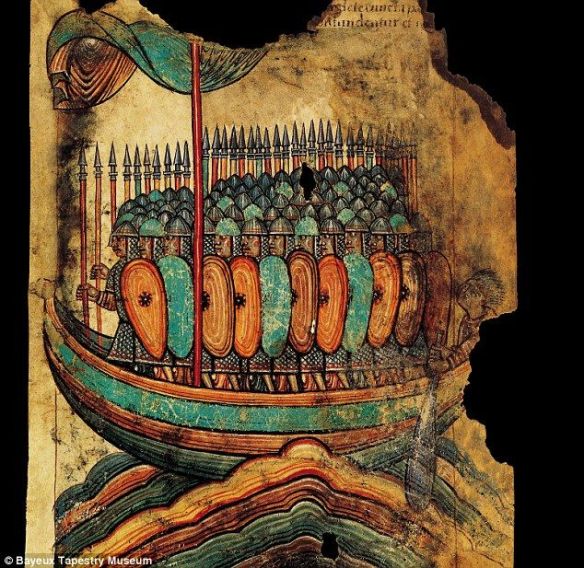
RAIDING FRANCE
This picture of a Viking ship is in a French manuscript from around 1100. Viking ships attacked French towns and monasteries all through the 9th century. One group of Vikings settled in the Seine region. Another band, under the chieftain Rollo, made their homes around Rouen. This area became known as Normandy, “Land of the Northmen.”
SOUVENIR OF PARIS
Paris was conquered on Easter Sunday, March 28, 845. Charles the Bald, the French king, had to pay the raiders 7,000 lb (3,150 kg) of silver to get peace. The Viking leader Ragnar even took a bar from the city gate as a souvenir. But he and most of his men died of disease on their way back to Scandinavia.
Whatever their motives may have been, from the early 800s on, the Vikings employed a mix of aggressive tactics against foreign lands, including large-scale raids, the creation of winter bases, and invasions and attempts to set up small kingdoms, as local circumstances seemed to warrant them. A clear example of this mixed approach can be seen in the way the Vikings targeted the Franks throughout much of the ninth century.
The early medieval Franks were the direct forerunners of the French, Belgians, Dutch, and western Germans. During the Viking Age, large Frankish kingdoms covered much of what are now France, Belgium, the Netherlands, and Germany. Some early Viking raids occurred along the Frankish coasts, from the mouth of the Seine River northward to Frisia, between 799 and 820. Many of the attackers were driven away because Frankish coastal defenses were strong and well organized. But as happened in England, Ireland, and elsewhere, the raids on the Franks sharply increased in intensity in the 830s. In 834 a Viking fleet sacked Dorestad, an important trading city in what is now the Netherlands. And seven years later another raiding party sailed up the Seine and attacked Rouen (now in France). In 843 Nantes, on the Loire, was looted, and the Vikings set up a permanent base near the mouth of that river. A similar base appeared a few years later on the island of Oissel, in the Seine.
Meanwhile, another band of Vikings attacked Paris in 845. Charles the Bald, ruler of the western Frankish kingdom, paid them 7,000 pounds (3,157kg) of silver to go away, the first of thirteen Danegolds paid by Frankish leaders between that year and 926. But these payments failed to keep the Vikings out of the region. Some of them established a small kingdom centered on Dorestad in 850, and individual raids continued in the next two decades. A French monk of that period lamented:
The number of ships grows. The endless stream of Vikings never ceases to increase. Everywhere the Christians are victims of massacres, burnings, plunderings. The Vikings conquer all in their path. . . . Rouen is laid waste . . . Paris, Beauvais, and Meaux taken, Melun’s strong fortress leveled to the ground, Chartres occupied . . . and every town besieged.
Though these raids took a toll, the Vikings eventually encountered stiff resistance in the Frankish lands. In the 860s a number of local noblemen organized defensive forces and delivered the intruders a series of sound defeats. And the same thing happened later. The Vikings attacked Paris again in 885, but a local ruler, Count Odo, drove them away from the Seine region four years later. They then tried to conquer Brittany, in western France, but were foiled there as well.